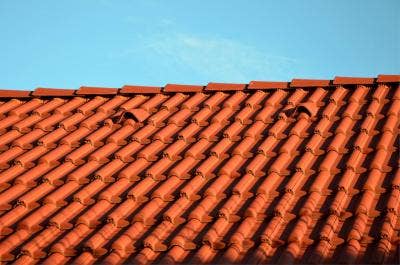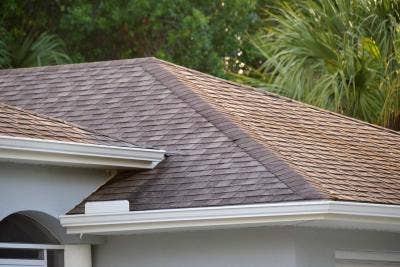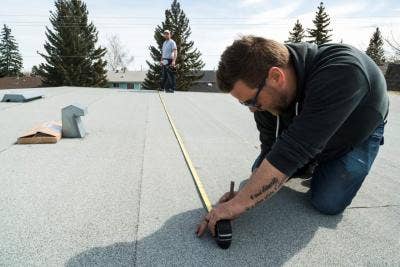The History of Clay Tiles

Think of clay tiles on our homes and it's likely our minds will drift to a quintessential English scene, rows of houses with distinctive red roofs, made up of evenly distributed straight edged tiles the kind you probably drew as a child in school.
Indeed, clay tiles have been a fixture of the English landscape for many hundreds of years, a staple of the buildings to adorn our towns, cities, villages and hamlets throughout this sceptred isle. Did you know, however, that the use of clay as a roofing tile pre-dates even the old English uses of the Middle Ages, playing an ancient and really rather global part in the ancient history of the roofing industry itself?
Clay Roof Tiles' Ancient Origins

A cat's paw print found on an Ancient Roman Clay Tile. Estimated to be 2000 years old.
It's fair to say that clay has been a staple of the roofing industry across varied locations in the world for about as long as people have been putting shelter atop their homes that didn't consist of animal parts.
Archaeologists have been able to trace the use of clay roof tiles in ancient China from as far back as 10,000 BC which I think we can all agree, was a long time ago indeed.
From these ancient origins did clay become a primary material for roofing across Asia in the multiple millennia that followed. Discoveries have also unearthed fairly clear evidence that clay roof tiles were being used across various parts of the Middle East in these pre-Christ centuries.
And then there were the great ancient Empires that we loved to read about in history lessons: Egypt, Greece and Rome.
Certain forms of clay tiling were used upon the roofs of some ancient Greek dwellings while the material also found favour among Egyptian builders of the time. And there is plenty of compelling evidence to demonstrate a fairly common use of clay as a roof tile throughout the different regions that the Roman's influence touched upon.
Including in England. Roman influence in ancient Britain included the introduction of clay roof tiles. With a typically innovative flourish, the Roman's adopted an 'Over & Under' clay tile structure. A flat tray with curved sides lay flat to the roof while a cylindrical tile was overlaid to cover the joints and create a waterproof roof.
Into the Middle Ages
Prompted by frequent invasions from Barbarian armies, the Romans decided the time was right to up sticks and depart Britain during the 5th Century AD. And while their legacy would endure in some instances, using clay as a tile appeared not to be one of them.
With the exception of a handful of monasteries across England, the creatively crafted clay tiles of the Roman era was somewhat forgotten by the Britons, with thatched roof dwellings becoming de rigueur. And, as we've discussed previously, it was a reliance on different kinds of thatched roofing which would be the standard on homes and buildings throughout England for the best part of 400 years in the early medieval period.
In fact, the use of clay as a roofing tile wouldn't feature upon the English landscape with any prominence until sometime into the 13th Century. The clay tiles of this era were simple designs flat rectangles, conveniently sized (at approximately 10½ x 6½ inches). Referred to as peg tiles, they had small holes at the edge into which you inserted pegs to hold in place. They were laid in an overlapping fashion flat to the roof structure, much as you might find tiles laid in the centuries that followed after.
Following the Great Fire of Southwark (in London) in 1212 AD King John (he of the Robin Hood legend), decreed that buildings in the city adopt clay tiles as they presented less risk. Similarly, in light of the fire and potential risk that thatched roofs presented in a built up area, the Archbishop of Canterbury ordered all buildings in the vicinity of the church to adopt clay roof tiles from that day forth.
With such decrees came about an era of clay tile usage across England, with a standardised size (ten by six) fixed into law by Edward IV in 1477 and still considered the standard to this day. In the years, decades and centuries that followed, throughout the length and breadth of England distinctive red and orange tiled roofs would become a feature of rural and urban living. Each region would have its ow kilns, from which clay tiles for local use would be created and the large-scale production of clay tiles would form the backbone of areas such as Staffordshire, Leicestershire and Shropshire as the Industrial Revolution took hold on the country.
While clay remained a key material for roof tiles in the country, regional differences would also dictate the use of other materials, most notably slate. As transportation improved making slate easier to move, so it cropped up more regularly in different parts of the country.
To this day clay, alongside slate, remains a standard tile for the UK roof industry. Manufacturers such as Redland & Marley have helped cement clay roof tiles as a popular choice for house builders in 2023. Design and technology has brought improvements to their efficiency and installation, but much of their appeal, their durability and rustic charm and attractive colours especially, has endured through the ages. Roof tops across the country still appeal thanks to the distinctive reds of English clay from new homes to the restoration of period buildings. Clay has a rich global history going back to the earliest days of the roofing industry and it continues to enjoy popular appeal for roof builders and homeowners alike, today and into the future.
View our range of Clay Tiles Here.
Our Top Videos.


How to install a Velux Integra Electric Roof Window (5 Parts)
In this five-part guide, we take you through the full installation of a Velux GGU Centre Pivot Integra Roof Window onto an...


How to install a Duratech Centre-Pivot Pine Roof Window
Once you begin unpackaging the window, you’ll find in the box the brackets, the handle and the fixings. And there will also be some instructions...
Ideas & Advice
How-tos, tutorials and videos


How and why to use or snap a chalk line
Chalk lines are the fastest way to mark straight guidelines on flat surfaces. They are used extensively in the building and construction industry to speedily and accurately ‘draw’ straight lines between two points. Chalk lines are inexpensive tools...


Skylight Blinds: A Guide To The Different Types
Like many household product, blinds for skylight windows come in all shapes, sizes, and materials. Some are designed with a tangible purpose in mind, while others are more for show. One thing’s for sure - buying any type of skylight blind...









